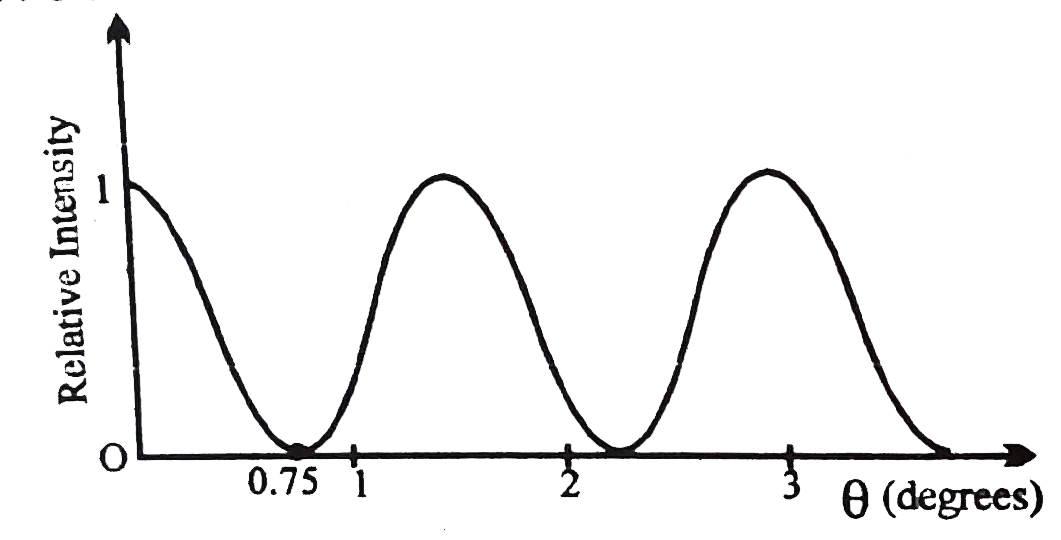Laser light of wavelength 630 nm incident on a pair of slits produces an interference pattern in which the fringes are seprated by 8.1mm .A second laser light produces an interference pattern in which the fringes are seprated by 7.2 mm .calculate the wavelength of the second light .
The correct Answer is:A, B, C, D
To solve the problem, we need to use the relationship between fringe width and wavelength in an interference pattern. The fringe width (β) is given by the formula:
β=λDd
where:
- β is the fringe width,
- λ is the wavelength of the light,
- D is the distance from the slits to the screen,
- d is the distance between the slits.
Since D and d are constants for both lasers, we can say that the fringe width is directly proportional to the wavelength:
β1∝λ1andβ2∝λ2
From this, we can establish the ratio:
β1β2=λ1λ2
Given:
- λ1=630nm
- β1=8.1mm
- β2=7.2mm
We need to find λ2. Rearranging the ratio gives us:
λ2=β2β1⋅λ1
Now, substituting the values:
λ2=7.2mm8.1mm⋅630nm
Calculating the fraction:
7.28.1=0.8889
Now, substituting this back into the equation for λ2:
λ2=0.8889⋅630nm≈560nm
Thus, the wavelength of the second light is approximately 560nm.
Summary of the Steps:
1. Write down the relationship between fringe width and wavelength.
2. Establish the proportionality between the two sets of data.
3. Rearrange the equation to solve for the unknown wavelength.
4. Substitute the known values and calculate the result.
- β is the fringe width,
- λ is the wavelength of the light,
- D is the distance from the slits to the screen,
- d is the distance between the slits.
- λ1=630nm
- β1=8.1mm
- β2=7.2mm
1. Write down the relationship between fringe width and wavelength.
2. Establish the proportionality between the two sets of data.
3. Rearrange the equation to solve for the unknown wavelength.
4. Substitute the known values and calculate the result.
Topper's Solved these Questions
- GRAVITATION Book:AAKASH INSTITUTE ENGLISHChapter:GRAVITATION Exercise:ASSIGNMENT SECTION -G (Integer Answer Type Questions)
Explore 6 Videos
- GRAVITATION Book:AAKASH INSTITUTE ENGLISHChapter:GRAVITATION Exercise:ASSIGNMENT SECTION -H (Multiple True - False Type Questions)
Explore 5 Videos
- GRAVITATION Book:AAKASH INSTITUTE ENGLISHChapter:GRAVITATION Exercise:ASSIGNMENT SECTION -E (Assertion - Reason Type Questions)
Explore 14 Videos
- ELECTROSTATIC POTENTIAL AND CAPACITANCE Book:AAKASH INSTITUTE ENGLISHChapter:ELECTROSTATIC POTENTIAL AND CAPACITANCE Exercise:ASSIGNMENT SECTION - D
Explore 9 Videos
- KINETIC THEORYBook:AAKASH INSTITUTE ENGLISHChapter:KINETIC THEORYExercise:EXERCISE (ASSIGNMENT) SECTION - D Assertion - Reason Type Questions
Explore 10 Videos
Similar Questions
Laser light of wavelength 1260 nm incident on a pair of slits produces an interference pattern in which the fringes are seprated by 8.1mm .A second laser light produces an interference pattern in which the fringes are seprated by 7.2 mm.Calculate the wavelength of the second light
View SolutionLaser light of wavelength 630 nm incident on a pair of slits produces an interference pattern in which the fringes are seprated by 8.1mm .A second laser light produces an interference pattern in which the fringes are seprated by 3.6 mm.Calculate the wavelength of the second light
View SolutionLaser light of wavelength 315 nm incident on a pair of slits produces an interference pattern in which the fringes are seprated by 8.1mm .A second laser light produces an interference pattern in which the fringes are seprated by 7.2 mm.Calculate the wavelength of the second light
View SolutionLaser light of wave length 600 nm incident on a pair of slits produces an interference pattern in which the bright fringes are separated by 8mm. A second light produces an interference pattern in which the fringes are separated by 12 mm. Calculate the wavelength of the second light.
View SolutionLaser light of wavelength 630nm incident on a pair of slits produces an interference pattern where bright fringes are separated by 8.1mm. Another light produces the interference pattern, where the bright fringes are separated by 7.2mm. Calculate the wavelength of second light.
View SolutionIn Young's double slit experiment ,momochromatic light of wavelength 630nm illuminates the pair of slits and produces an interface pattern pattern in which two consecutive bright frings are separated by 8.1mm. Another source of monochromatic light produce the interface pattern in which the two consecutive bright fringes are seperated by 7.2mm, find the wavelength of light from the second sources . What is the effect to on the interference fringes if the monochromatic sources is replaced by a source of white light ?
View SolutionLaser light of wavelength 630 nm is incident on a pair of slits which are separated by 1.8 mm. If the screen is kept 80 cm away from the two slits, calculate :
fringe separation i.e., fringe width
View SolutionLaser light of wavelength 630 nm is incident on a pair of slits which are separated by 1.8 mm. If the screen is kept 80 cm away from the two slits, calculate :
distance of 10th bright fringe from the centre of the interference pattern.
View SolutionLight of wavelength 600 nm is incident normally on a slit of width 0.2 mm. The angular width of central maxima in the diffraction pattern is
View SolutionLight of wavelength 520nm passing through a double slit,produced interference pattern of relative intensity versus deflection angle θ as shown in the figure.find the separation of between the slits.

View Solution
